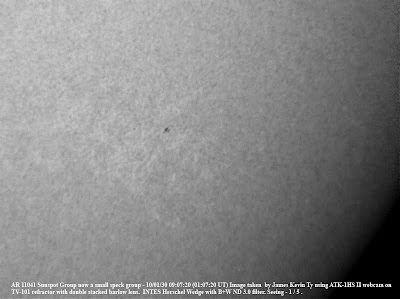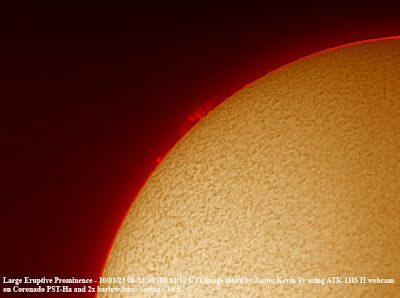Hello:In the early morning of January 1, some members of the Astronomical League of the Philippines (ALP) went to fellow ALPer Armandfo Lee's Astro Camp Observatory at SM MOA San Miguel by the Bay to observe and image the partial lunar eclipse. Among the members who participated were me, wife Charito and son Kendrick Cole Ty, Armando Lee, wife Mia , son Jason Lee & Mia's mom, Christopher "Benci" Lee and Sandra Torita, Kevin Dagunan and Mary Grace Gulde , Crispin "Mopper" Riosa and Ma. Theresa Masuay.
I arrived there 2pm as I had New Year celebration at my in-law's place. It was also a special day for astronomers as this Jan 1 has a unique rare blue Moon (meaning 2 full moons in a month) and a partial lunar eclipse altogether. As quoted by spaceweather.com , "Blue Moons are rare (once every 2.5 years). Blue Moons on New Year's Eve are rarer still (once every 19 years). How rare is a lunar eclipse of a Blue Moon on New Year's Eve?
A search of NASA's Five Millennium Catalogue of Lunar Eclipses provides an approximate answer. In the next 1000 years, Blue Moons on New Year's Eve will be eclipsed only 11 times (once every 91 years). A year of special note is 2848 when there will be two lunar eclipses in December--on Dec. 1st and Dec. 31st. Such a double-Blue Moon-lunar eclipse ending on New Year's Eve appears to be a millennium-level event. That's rare!!!"

When I arrived at the site, all the roads near the site were closed because there was a concert near the mall area and I had to park the car farther thus have to drag my setup to the observing site in a more tiring way :( Armand had warned me of the possible scenario earlier in the afternoon and that helps a lot as I opted to leave the planned use of my heavier refractor and mount and instead use the much lighter Meade ETX-90AT :) Its still a little heavy but to compare it with his usual TV-101 setup, it is almost 3x lighter :) LOL . Once I arrived at the observing site, I quickly do a rough polar alignment and had setup my imaging system in less than 10 minutes. I was able to start imaging at around 2:15am.
 Although umbra starts at around 2:53am, we were able to see the slight shading of the penumbra as early as 2:30am and become more pronounced at around 3:23am when maximum 8% umbra shading occurred. On the other hand, I already notice slight penumbral shading in his image at around 2:20am which started near the bright crater Tycho. The umbra shadow touches the southern part of the Moon only. One good note about this eclipse is the surprisingly clear sky that followed after the New Year Eve's fireworks :)
Although umbra starts at around 2:53am, we were able to see the slight shading of the penumbra as early as 2:30am and become more pronounced at around 3:23am when maximum 8% umbra shading occurred. On the other hand, I already notice slight penumbral shading in his image at around 2:20am which started near the bright crater Tycho. The umbra shadow touches the southern part of the Moon only. One good note about this eclipse is the surprisingly clear sky that followed after the New Year Eve's fireworks :)
At around 5:00am, James and Benci took their last image on the last visible trace of shading that can be seen in the camera viewfinder before calling it a day! Before they packed up their scope, they had a group picture taken for posterity. Happy New Year To All !!


Other activity shots I took that morning.

























































